#Duchess of Richmond's ball
Explore tagged Tumblr posts
Text
The Duchess of Richmond's ball was a ball hosted by Charlotte, Duchess of Richmond in Brussels on 15 June 1815, the night before the Battle of Quatre Bras. Charlotte's husband Charles Lennox, 4th Duke of Richmond, was in command of a reserve force in Brussels, which was protecting that city in case Napoleon Bonaparte invaded.
Elizabeth Longford described it as "the most famous ball in history". "The ball was certainly a brilliant affair", at which "with the exception of three generals, every officer high in [Wellington's] army was there to be seen".

Before Waterloo by Henry Nelson O'Neil
143 notes
·
View notes
Text





Cream silk gauze wedding dress from 1822
"The bride was Lady Jane Lennox and the dress was worn at her wedding to Laurence Peel on 20 July 1822. Jane was the daughter of the 4th Duke of Richmond, and Charlotte, Duchess of Richmond who hosted the famous Waterloo Ball in 1815. Laurence Peel was the younger brother of the Prime Minister, Sir Robert Peel."
Fashion Museum Bath via Instagram
#georgian era#georgian fashion#georgian#regency era#regency fashion#regency#fashion history#historical fashion#19th century
695 notes
·
View notes
Text
Time Travel Question : 19th Century IV and Earlier
These Questions are the result of suggestions from the previous iteration.
This category may include suggestions made too late to fall into the correct grouping.
Please add new suggestions below if you have them for future consideration.
#Time Travel#19th Century Paris#coca wine#absinthe#expressionists#19th Century#Pre-Raphaelites#Art History#Vienna#Statue of Liberty#Victor Hugo#Georg Wilhelm Steller#Steller's Sea Cows#18th Century#Extinct Animals#Sea Creatures#Duchess of Richmond#Brussels#Napoleonic Wars#Battle of Quatre Bras#South America#Charles Darwin#History of Science
169 notes
·
View notes
Text







Princess Madeleine Through the Years
Read her update below!!
HRH Princess Madeleine was often in the shadow of her older sister, Mary, Princess of the Isle who would later become Queen Mary III. Madeleine was often viewed by the media as the quiet and shy daughter of the King and Queen. Madeleine was rarely in scandal and her life was not nearly reported on as much as her siblings, Princess Mary & Prince Michael. During Princess Madeleine's early 20s, she was thought to have been linked with a family friend, Archibald Vernick.
Famed WAFTA award-winning actor Yusuf Raheem was seen at Princess Madeleine's 25th birthday celebrations. Princess Madeleine was seen leaving his apartment in San Myshuno multiple times throughout the year, sparking rumors of a relationship between the two. Yusuf Raheem was invited to spend Winterfest with the royal family at Statford Castle and was seen in the royal procession to St. George's Chapel. After a year and a half of dating, San Myshuno Palace announced that the couple were engaged. Three and a half months later, on July 15th, the wedding was held at St.Mary's Cathedral in Windenburg. The ceremony was televised and reportedly watched by 190 million viewers worldwide. Following the ceremony, a wedding breakfast was held at Angleterre Palace and a ball was thrown at Sulani House, hosted by Madeleine's cousin, Princess Margaret, Duchess of Montcroix. Princess Madeleine was given the titles Duchess of Richmond, Marchioness of Wixby, and Countess of Brancaster. Yusuf Raheem was reportedly offered a title but declined it. The couple moved into apartments in Kingston Palace which originally belonged to Princess Madeleine's great aunt, Princess Alice.
On May 25th, around 9 months after the wedding, Princess Madeleine gave birth to her first child, Prince Noah Ahmed Raheem. A year and a half later, on September 14th, Princess Madeleine gave birth to Princess Lina Marie Raheem. After five years of marriage, San Myshuno Palace announced that Princess Madeleine and Yusuf Raheem would be getting divorced. Many news outlets reported that Raheem cheated on Princess Madeleine throughout the marriage, however, Princess Madeleine denied these reports. The couple also reportedly conflicted over the Princess not supporting Raheem's acting career throughout the marriage. Allegedly Raheem was forced to give up acting jobs due to him being a member of the royal family. Princess Madeleine gave Raheem 6 million dollars in their divorce settlement. The former couple are reportedly on friendly terms, with Yusuf Raheem seen attending a few royal family events such as the 45th birthday celebrations of Queen Mary.
Prince Noah & Princess Lina were raised primarily in San Myshuno and split time between their mother's apartments at Kingston Palace and their father's penthouse in San Myshuno. The children spent many summers with their mother at her summer residence, Primrose Cottage, a house on the Statford Castle Estate. The children attended Alcott Nursery School and Canterbury Academy. Prince Noah attended Wroxham University, graduating with a degree in business management. Meanwhile, his younger sister, Princess Lina, attended Witham University, majoring in Political Science. Over the last few years, Prince Noah and Princess Lina have been in regular attendance at royal family events with their mother. Prince Noah and Princess Lina have attended a few of their father's movie premieres in Simerica and San Myshuno over the last few years.
Princess Madeleine has taken an average of 190 engagements a year for the last 15 years. Princess Madeleine is one of the hardest-working members of the royal family and is a patron to over 150 organizations and charities including the Windenburg Women's Institute. Princess Madeleine's charities and organizations primarily aim at raising awareness about disabilities and mental health. Princess Madeleine has consistently been ranked as the second most popular member of the royal family, usually behind the Queen herself.
39 notes
·
View notes
Text

An exclusive scene from Napoleon. This comes in the run up to the final confrontation at [SPOILERS] Waterloo.
INT - DUCHESS OF RICHMOND'S BALL, TEA TABLE NIGHT
WELLINGTON
Have some Boeuf en croute Henry
UXBRIDGE
(disgusted)
It's tough as an old boot!
CHEF
Your grace, in your honour I have named this dish after
you and from now on it shall be called Beef Well…
MESSENGER enters dramatically, his uniform dishevelled
MESSENGER
Napoleon has crossed the border! He’s marching on us.
WELLINGTON
Good lord, he’s humbugged us!
1 note
·
View note
Photo

Julian Fellowes' Belgravia is the story of a secret. A secret that unravels behind the porticoed doors of London's grandest postcode. Set in the 1840s when the upper echelons of society began to rub shoulders with the emerging industrial nouveau riche, Belgravia is peopled by a rich cast of characters. But the story begins on the eve of the Battle of Waterloo in 1815. At the Duchess of Richmond's new legendary ball, one family's life will change forever.
Call Number: F FEL
Also available in: large print, eaudiobook, ebook
0 notes
Text
At the Ball
by DarkDancer72
On the night of the 15/16 June, as war marches ever closer to Brussels, Major Israel Hands and Lieutenant Lucius Spriggs attend the Duchess of Richmond’s Ball.
Words: 2353, Chapters: 1/1, Language: English
Fandoms: Our Flag Means Death (TV)
Rating: Mature
Warnings: No Archive Warnings Apply
Categories: M/M
Characters: Israel Hands, Lucius Spriggs, Arthur Wellesley 1st Duke of Wellington
Relationships: Israel Hands/Lucius Spriggs
Additional Tags: Battle of Waterloo, Animal Death, Serious Injuries, Implied Sexual Content, Alternate Universe - Regency, Historical Accuracy - more or less, Duchess of Richmond’s Ball, Waltzing, Referenced deaths and injuries in battle
source https://archiveofourown.org/works/45226540
0 notes
Text
"VANITY FAIR" (1987) Review
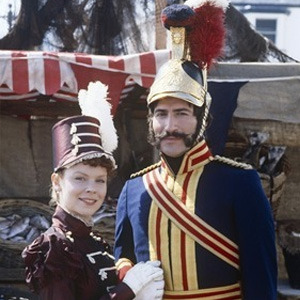
"VANITY FAIR" (1987) Review I found myself wondering how many adaptations of William Makepeace Thackeray's 1847-1848 novel there have been. As it turned out, this is one piece of literature that has been adapted countless number of times - in film, radio and television. I have seen at least five adaptations myself. And one of them turned out to be the sixteen-part television miniseries that aired on the BBC in 1987.
Since Thackeray's novel is a very familiar tale, I will give a brief recount. Adapted by Alexander Baron and directed by Michael Owen Morris, "VANITY FAIR" told the story of one Rebecca "Becky" Sharp, an impoverished daughter of an English art teacher and French dancer in late Georgian Britain. Determined to climb her way out of poverty and into society, Becky manages to befriend Amelia Sedley, the daughter of a wealthy London merchant. When both finally graduate from Miss Pinkerton's School for Girls, Becky is invited to spend some time with Amelia's family, before she has to assume duties as a governess to the daughters of a minor baronet and landowner named Sir Pitt Crawley. During her time with the Sedleys, she almost manages to snare Amelia's older brother, Jos, a "nabob" from India, as a husband. But the interference of George Osborne, the son of another merchant who happens to Amelia's heart desire, leaves Becky single and employment as a governess. However, upon her arrival at Queen's Crawley, the Crawleys' estate, Becky's charm and wiles inflict a shake-up with the family that would influence lives for years to come. While viewing "VANITY FAIR", it occurred to me that it is really a product of its time. Although not completely faithful to Thackeray's novel, it struck me as being more so than any adaptation I have seen. Most literary adaptations on television tend to be rather faithful - at least between the 1970s and the 1990s. Especially during the decade of the 1980s. Another sign of this miniseries being a product of its age is the quality of its photography. It is rather faded - typical of many such productions during the 1970s and 1980s. But for me, complete faithfulness to a literary source is not a true sign of the quality of a television adaptation. Nor the quality of the film it was shot on. So, how do I feel about "VANITY FAIR"? Remember the miniseries' faded look I had commented upon? I really wish it had been shot on better film stock. Stuart Murdoch and Mickey Edwards' visual effects struck me as too eye-catching to be wasted on film stock that quickly faded with time. Another problem I had proved to be the episode that centered around the Battle of Waterloo. I realize that it would make sense for the most of episode's narrative to be told from Becky Sharp Crawley's point of view. Yet, considering that it was able to feature the discovery of one dead character on the battlefield, I wish the episode had been willing to embellish the sequence a bit more. The sequence featured a great deal on Becky and Amelia saying good-bye to their respective spouses, along with Becky bargaining with Jos Sedley over her husband's horses. Overall, the entire sequence . . . nearly the entire episode seemed to lack a sense of urgency over the entire Waterloo campaign and how it affected the main characters. I have one last complaint about "VANITY FAIR" . . . namely the Maquis of Steyne. To be honest, my complaint against him is rather minor. I have a complaint against his physical appearance. Thanks to Lesley Weaver's makeup, I could barely make out actor John Shrapnel's features. He seemed to be a whole mass of hair and whiskers plastered on a slightly reddish countenance. On the other hand, I really enjoyed how the production went into full detail of Thackeray's novel. Was it completely faithful? I rather doubt it. I noticed how Alexander Baron's screenplay did not adhere to Thackeray's rather nasty portrayal of non-white characters such as Miss Schwartz. Thankfully. On the other hand, Baron, along with director Michael Owen Morris did an excellent job in their portrayals of the novel's main characters - especially Rebecca Sharp, Rawdon Crawley, Amelia Sedley, Jos Sedley, George Osborne, Mr. Osborne and William Dobbin. I will be honest. My favorite segments of the production . . . are basically my favorite segments of the novel. I enjoyed the production's re-creation of Becky's story that began with her departure from Miss Pinkerton's School for Girls to hers and Amelia's adventures during the Waterloo campaign. Despite the miniseries' limited photography, I must admit there are other aspects of "VANITY FAIR" that impressed me. I enjoyed Gavin Davies and Sally Engelbach's production designs. Both did an admirable of re-creating the production's setting of early 19th century Britain, Belgium, France and Germany. They were ably assisted by set decorations created by the art department, led by David Ackrill and Tony Fisher. But I really must commend Joyce Hawkins' costume designs. I found them colorful and tailor-made. I also thought Ms. Hawkins did an excellent job in her re-creation of the early 19th century fashions. There is one segment in Thackeray's story I found difficult to enjoy - namely Becky's rise in British society, her relationship with the Maquis of Steyne, the exposure of her as a cold parent and ending with the destruction of her marriage to Rawdon. It is not the fault of Baron, Morris or Thackeray. It is simply my least favorite part of the story. During this segment, Becky transformed from a morally questionable anti-heroine to an outright villainess. Perhaps this is why I found it difficult to revel in Becky's eventual fall. One, I found this portrayal of Becky a bit too one-dimensional for my tastes. Two, there seemed to be this underlying theme in Becky's downfall that she deserved it for being too ambitious, not knowing her place and not being the ideal woman. I realize that I should sweep these feelings away in the wake of her last crime. But for some reason, I cannot. A part of me wonders, to this day, if Thackeray had went too far in this transformation of Becky's character. I did not have a problem with the performances featured in "VANITY FAIR". If I must be honest, I found them to be very competent. Morris handled his cast very well. The miniseries featured solid performances from Fiona Walker, Shaughan Seymour, Gillian Raine, Tony Doyle, Malcolm Terris, Vicky Licorish, Eileen Colgan, Irene MacDougall, Alan Surtees, and David Horovitch. I also enjoyed the performances from the likes of Freddie Jones, who made a very lively Sir Pitt Crawley; John Shrapnel, who gave an intimidating portrayal of the Maquis of Steyne, underneath the makeup and wig; Siân Phillips, who struck me as a very entertaining Matilda Crawley; David Swift, whose portrayal of Mr. Sedley seemed to reek with pathos; and Philippa Urquhart, who was excellent as the malleable Mrs. Briggs. But there were those performances that truly impressed me. Robert Lang gave an excellent performance as the ruthless and ambitious Mr. Osborne, who seemed to be handicapped by his own stubborness. Benedict Taylor did a superb job in portraying the varied nature of George Osborne - his charm, his shallowness and selfish streak. James Saxon was equally impressive as the insecure, yet vain Joseph "Jos" Sedley. Simon Dormandy gave a very complex and skillful performance as the priggish William Dobbin, a character I have always harbored mixed feelings about. I personally think that Jack Klaff made the best on-screen Rawdon Crawley I have seen on-screen, so far. Although his character has always been described as an affable, yet empty-headed man who eventually realized he had married a woman beyond his depth. Klaff did an excellent job of conveying those traits more than actor I have seen in the role. Rebecca Saire seemed perfectly cast as the demure, yet shallow Amelia Sedley, who spent years infatuated with a man she never really knew or understood. It is not often I find an actress who does an excellent of portraying a girl in a woman's body, who at the end, is forced to grow up due to an unpleasant realization. If Saire seemed perfectly cast as the childish Amelia, Eve Matheson struck me as even more perfect as the charming and manipulative Rebecca Sharp. Unlike other actresses who have portrayed Becky, I would never describe Matheson as a beauty, despite being physically attractive. What I found impressive about Matheson's performance is the manner in which she conveyed Becky's ability to charm and seduce others, utilizing her eyes, mannerisms, the ability to cry on cue and her voice. Matheson managed to portray Becky as the most desirable woman around. I have never seen another on screen Becky Sharp who managed to ooze charm and seduction the way Matheson did. And yet, she also managed to convey Becky's unpleasant side without being theatrical about it. Someone had once described Matheson's Beck as "spunky". Oh please. Spunky? The 1987 Rebecca Sharp was a lot more than that, thanks to Matheson's performance. Dammit, the woman should have received some kind of award for her performance. She was that good. I have a few quibbles about "VANITY FAIR". Basically, I wish the miniseries had been shot on better film stock. And I wish that the Waterloo sequence had been a bit more . . . embellished. Otherwise, I feel that this 1987 adaptation of William Makepeace Thackeray's novel is the best I have seen so far. I am flabbergasted at how close I came to ignoring this production altogether.
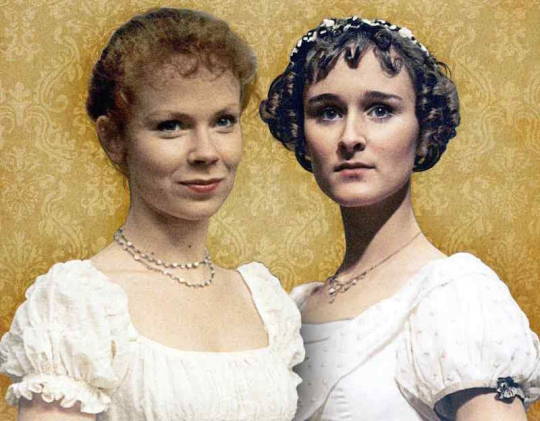
#vanity fair#vanity fair 1987#William Makepeace Thackeray#alexander baron#michael owen morris#waterloo#duchess of richmond's ball#eve matheson#jack klaff#rebecca saire#benedict taylor#fiona walker#david horovitch#freddie jones#john shrapnel#sian phillips#david swift#philippa urquhart#robert lang#james saxon#simon dormandy#malcolm terris#napoleonic wars#period drama#period dramas#costume drama
1 note
·
View note
Text
The Eve of Waterloo
Lord Byron
There was a sound of revelry by night, And Belgium's capital had gathered then Her beauty and her chivalry, and bright The lamps shone o'er fair women and brave men. A thousand hearts beat happily; and when Music arose with its voluptuous swell, Soft eyes looked love to eyes which spake again, And all went merry as a marriage bell; But hush! hark! a deep sound strikes like a rising knell!
Did ye not hear it? -- No; 'twas but the wind, Or the car rattling o'er the stony street; On with the dance! let joy be unconfined; No sleep till morn, when youth and pleasure meet To chase the glowing hours with flying feet. But hark! -- that heavy sound breaks in once more, As if the clouds its echo would repeat; And nearer, clearer, deadlier than before; Arm! arm! it is -- it is -- the cannon's opening roar!
Within a windowed niche of that high hall Sate Brunswick's fated chieftain; he did hear That sound the first amidst the festival, And caught its tone with death's prophetic ear; And when they smiled because he deemed it near, His heart more truly knew that peal too well Which stretched his father on a bloody bier, And roused the vengeance blood alone could quell; He rushed into the field, and, foremost fighting, fell.
Ah! then and there was hurrying to and fro, And gathering tears, and tremblings of distress, And cheeks all pale, which, but an hour ago, Blushed at the praise of their own loveliness. And there were sudden partings, such as press The life from out young hearts, and choking sighs Which ne'er might be repeated; who would guess If ever more should meet those mutual eyes, Since upon night so sweet such awful morn could rise!
And there was mounting in hot haste; the steed, The mustering squadron, and the clattering car, Went pouring forward with impetuous speed, And swiftly forming in the ranks of war; And the deep thunder, peal on peal afar; And near, the beat of the alarming drum Roused up the soldier ere the morning star; While thronged the citizens with terror dumb, Or whispering, with white lips -- "The foe! they come! they come!"
1 note
·
View note
Text
I saw an article earlier today comparing Richard Sharpe to Becky Sharp and how the timeline of both characters makes it possible for them to have had the same father, and I shit you not my MIND IS RACING.
#sharpe#vanity fair#richard sharpe#becky sharp#regency era#they were also both at the duchess of richmond's ball#albeit for quite different reasons#just the crossover fanfic potential tho#i feel like i'm on the verge of uncovering some sort of interconnected grand regency literary universe
12 notes
·
View notes
Text



The Duchess of Richmond’s ball, Waterloo (1970)
#Dude-watchin’ with the Duchess of Richmond#this is so fucking funny#my sense of humour is lowbrow to say the least#waterloo 1970
35 notes
·
View notes
Text

The Duchess of Richmond's ball by Robert Alexander Hillingford
#duchess of richmond#ball#charlotte#battle of quatre bras#art#painting#history#robert alexander hillingford#brussels#napoleon bonaparte#duke of wellington#battle of waterloo#waterloo#britain#france#belgium#napoleonic#napoleonic wars#england#great britain
8 notes
·
View notes
Photo

The Duchess of Richmond's ball was a ball hosted by Charlotte, Duchess of Richmond in Brussels on 15 June 1815, the night before the Battle of Quatre Bras. Charlotte's husband Charles Lennox, 4th Duke of Richmond, was in command of a reserve force in Brussels, which was protecting that city in case Napoleon Bonaparte invaded.
Elizabeth Longford described it as "the most famous ball in history". "The ball was certainly a brilliant affair", at which "with the exception of three generals, every officer high in [Wellington's] army was there to be seen".
The proceedings were interrupted soon after the arrival of the Duke of Wellington, when he was notified of Napoleon's unexpected advance on the nearby crossroads of Quatre Bras. This forced him to depart after ordering his officers to leave to join their regiments. Some of the officers would soon die in battle and the poignancy of the drama has provided an enduring theme for artists, novelists and poets.
https://en.wikipedia.org/wiki/Duchess_of_Richmond%27s_ball
5 notes
·
View notes
Text

Thomas Montagu, Earl of Salisbury, Viscount Monthermer, (1784-1821)
“See that young man who dwells inside his body like an uninvited guest/ See the tunnel twist/ Clutch your birthright in your fist” - Birth of Serpents by the Mountain Goats
Wikipedia-type character bio below the cut.
*Mentions of suicide and drug overdose in the end.
Thomas Montagu, Earl of Salisbury and Viscount Monthermer (1784-1821) was a British Army aide de camp and intelligence officer during the Napoleonic Wars.
Biography
Thomas Montagu was the son of Edward Montagu, Earl of Salisbury and his wife Charlotte Montagu, Countess of Salisbury. The youngest of four brothers, but the one to inherit the earldom and viscountcy due to the deaths of his elder brothers in the American War of Independence.
Upon his father’s death at the Battle of Boxtel in 1794, he assumed the family seat in Yorkshire with his then-widowed mother soon afterwards. He attended Westminster School, and attended Oxford afterwards for a month before purchasing a cornet’s commission in the 12th Light Dragoons in 1800. He accompanied the regiment during the Egyptian Campaign, participating in the Battle of Alexandria and following actions.
He returned to the United Kingdom in 1802, being posted to Ireland with the regiment; first in Limerick, then Dublin, for the next two years. He was then sent to Dorsetshire along with the regiment in 1805, but did not participate in the Walcheren Expedition in 1809, having been appointed as an aide de camp to General Wellesley, later the Duke of Wellington, in 1808.
In the Peninsula, he witnessed many of the actions of the war, from Roliça to Badajoz in 1812, even joining in the storm of the town. It was also during his time in the Peninsula that he became involved in the British intelligence network in Spain and Portugal, aiding in the decryption of the Great Paris Cypher and becoming an exploring officer.
After a duel with Major Sir Richard Amcotts, a cousin of his wife, in which Amcotts was permanently and severely injured, Montagu was sent to Russia to join General Wilson’s staff as an official British observer of the French invasion of Russia.
He was called back to the Peninsula in September 1812 and assumed his previous position on Wellington’ staff in January of 1813, and was present at many of the following actions of the war, including the Battle of Vittoria and the Battle of Toulouse.
He returned to Britain in 1814 and married Princess Amelia von Regenstein after his previous wife’s death in 1813. He also fathered an illegitimate child by Princess Caroline von Regenstein in 1814, but the child was claimed by the Prince of Regenstein, the husband of the princess and Montagu’s lover.
He travelled to Brussels to assume his position as an aide de camp to the then Duke of Wellington for the Waterloo campaign, accompanied by his wife in 1815. He was present at the Duchess of Richmond’s ball. He was severely wounded during the Battle of Waterloo, in which the Prince of Regenstein was killed while serving as an officer of the King’s German Legion. He returned to Britain soon afterwards, not accompanying the British Army during the Occupation of Paris, and retired from the army as a lieutenant colonel.
He spent the last few years of his life on his estate in Yorkshire, dying in 1821.
Personal Life
His first marriage in 1807 to Emily Amcotts, the daughter of Sir Richard Amcotts, was unhappy according to many mentions in contemporary sources. No children resulted from this marriage before Lady Salisbury’s death in 1813.
He also had a mistress, Emma Nisbett, from 1807 to 1808, when she died giving birth to his illegitimate child, whom he placed with a different family and had no further involvement with.
His second marriage to Princess Amelia von Regenstein, the younger sister of Prince Frederick von Regenstein, was much more amicable, and two children resulted from the marriage before Montagu’s death in 1821.
Montagu was engaged in a ménage à trois with Princess Caroline von Regenstein and her husband, Prince Frederick von Regenstein, whom he first met in 1794 when the prince, then a count, was residing with his maternal uncle, the Marquess of Houlsyke, in Yorkshire. The two men were lovers from about 1803 to the prince’s death in 1815. However the two were close friends from 1794 to 1803, as can be seen from their surviving letters. Many passionate letters between the two survive from the collections of Regenstein’s wife, who was also romantically involved with him from around 1808 to 1815. Montagu’s relationship with the princess ended upon the prince’s death.
Personality
Montagu was a deeply private man during his life, but some of his personality can be gleaned from various records and papers left that relate to him, or were written by him. Mentions of him in contemporary sources by those not of his immediate circle often described him as cold and impersonal. However, his surviving private correspondence with those of his immediate circle shows the opposite, if not completely.
Death
He died in 1821 as a result of either tuberculosis or an opium overdose. Although a case has been made for a suicide, the specific details surrounding his death are unknown.
#my ocs#thomas montagu#ok to rb#i have so much specific info for these characters that i could very much write a wikipedia-esque article about them and i did#see. those hours of research weren't all for nothing.#also i'm kinda playing fast and loose with some of the dates and historical events here so. yeah. also some of the plot too but you get-#-the general idea#1/3 of a set for the main characters. hopefully. if i get enough motivation to do this same thing for the other two#i know very well that he isn't the best character ever morally. some of the stuff that he does is weird and questionable at best and-#-horrible at worst
27 notes
·
View notes
Text
The Scots Greys and the turning of the tide at Battle of Waterloo

They never consider the situation, never think of manoeuvring before an enemy and never keep back or provide a reserve. They’re charging at everything!
- Duke of Wellington reflecting on the charge of the British cavalry after the Battle of Maguilla in 1812
The Duke of Wellington was never pleased with his cavalry. In Spain he condemned them for “charging at everything”, getting cut up in the process or finding themselves on a distant part of the battlefield, horses blown, at the very moment they were needed elsewhere. So at Waterloo the Iron Duke intended to keep the mounted arm on a tight rein.
It was, after all, the first time he would actually face Napoleon in the field, and the situation was not auspicious. He had been taken by surprise. He famously learnt of the sudden appearance of the French on the border with the Southern Netherlands (now Belgium) at the Duchess of Richmond’s ball in Brussels on 15 June. “Napoleon has humbugged me, by God!” The following day his Prussian allies were worsted at Ligny. Hs own troops, rushed forward to nearby Quatre Bras, were badly mauled. He was on the back foot.
But his capacity to anticipate setbacks paid dividends. Some weeks earlier he had chosen a piece of ground on which to make a stand if the French were to come. The ridge of Mont St Jean, a mile south of the village of Waterloo athwart the main road from Charleroi to Brussels. The ridge ran north-east to south-west for about three miles, two-thirds of which Wellington was able to occupy with infantry and artillery. To support these he would post two brigades of light cavalry on the left (east) flank and three on the right. Two brigades of heavy cavalry, including the Scots Greys or, as they were then more properly known, the 2nd Royal (North British) Dragoons, would be in the centre. And to each of the cavalry brigadiers, as well as to the Earl of Uxbridge (later Marquess of Anglesey), the commander of the Allied cavalry and his second in command, Wellington gave strict instructions not to leave their positions without his express order.
The Duke was essentially a general who preferred to choose his ground, make the enemy attack him and then use the superior musketry of his infantry to defeat them. He intended Waterloo to be just such a battle. In addition, for the first time he had the benefit of a strong force of heavy cavalry inclusing the Scots Greys – bigger men, bigger swords, bigger horses – to counter the French heavy cavalry or break up an assault that threatened to overwhelm his infantry. And, indeed, the charge of these two brigades, best known perhaps for Lady (Elizabeth) Butler’s 1881 painting Scotland Forever! depicting the Scots Greys galloping wildly at the French, would be one of the critical actions of the battle, even, some argue, its turning point.
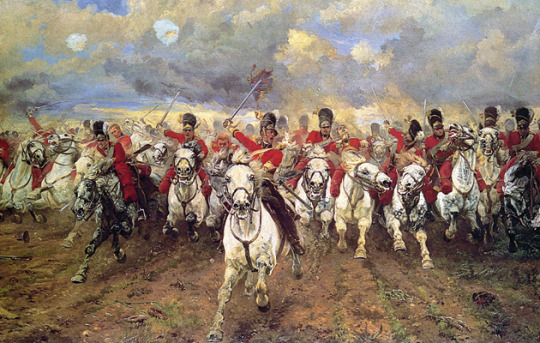
The Scots Greys had been formed in 1681 from a number of independent troops of dragoons (originally men who dismounted to fight with the musket, rather than fight from the saddle with sword and pistol), and known as The Royal Regiment of Scots Dragoons. The “grey” of their later title may at this time have referred to their uniform, for it was not for a dozen years that this changed to red, and there is no record that the Scots Greys used grey horses exclusively.
However, when inspected by King William III (William of Orange) in 1693 it was noted that the Scots Greys regiment were all mounted on greys. Soon afterwards they were being referred to as the “Grey Dragoons” or the “Scots Regiment of Grey Dragoons”. In 1707, after the Act of Union, they were restyled “North British”, as the parliamentary union envisaged Scotland to be. Not until 1877 would their nickname be made official. They became the 2nd Dragoons (Royal Scots Greys), inverted after the First World War to The Royal Scots Greys (2nd Dragoons). They kept this title for 50 years until amalgamating with the 3rd Carabiniers (Prince of Wales’s Dragoon Guards) to form the Royal Scots Dragoon Guards (Carabiniers and Greys).
When Napoleon escaped from Elba at the end of February 1815 to begin his “Hundred Days”, the ill-starred attempt to retake the French crown and continue his imperial ambitions, the Greys were one of a number of regiments rushed to Belgium that had yet to fight “Napoleonic” troops. Indeed, by the time of Waterloo few Scots Greys had seen battle - and they were keen to make up for it.
Their moment came in the early afternoon of 18 June, when it looked as if Wellington’s line at Waterloo would break. The Comte d’Erlon’s corps of three infantry divisions, some 14,000 men, with 6,000 cavalry, assaulted the Allied left wing and centre, which was held by Dutch-Belgian brigades and Lieutenant-General Sir Thomas Picton’s 5th Division, the latter experienced Peninsular troops.
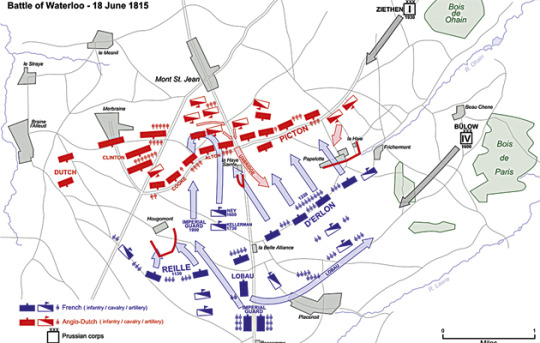
As d’Erlon’s men ascended the slope towards the sunken road that ran the length of the ridge left of La Haye Sainte, driving back the British skirmishers and reaching the thick hedge that fringed the road, Picton’s men stood up, formed into a four-deep line to guard against cavalry attack, advanced and began volleying.
However, the French deployed unusually quickly into line and returned fire. Picton himself was killed after ordering a counter-attack in language profane even by his own legendary standards, and soon his troops were giving way under the pressure of numbers. At two o’clock Napoleon appeared to be winning the Battle of Waterloo.
But Lieutenant-General the Earl of Uxbridge was a cavalry commander of genius. Earlier estranged from Wellington on account of eloping with the Duke’s youngest brother’s wife, he had been disbarred from service in the Peninsula after brilliantly covering Sir John Moore’s gruelling retreat to Corunna. But his cavalry coup d’oeil had not deserted him, nor his moral courage. Despite the Duke’s orders that none of the cavalry was to quit the ground it had been posted on without his express will, Uxbridge ordered his two brigades – the Household Brigade (1st and 2nd Life Guards, Royal Horse Guards and 1st (King’s) Dragoon Guards) and the Union Brigade, so-called for its English, Scots and Irish regiments (1st Royal Dragoons, 6th (Inniskilling) Dragoons, and the Scots Greys) – to charge in support of the hard-pressed infantry.
With a combined strength of nearly 2,500 sabres and led by Uxbridge, the heavies advanced. The Household Brigade was first into the charge, sweeping back the cuirassiers guarding d’Erlon’s left flank. To the Household’s left the Union Brigade surged through the lines of red-coated infantry in the sunken road, where some Gordon Highlanders grasped their stirrups to get at the French, and at the foot of the slope routed the two advanced infantry brigades of General Joachim Quiot’s division, the Royals, capturing the eagle of the 105th Ligne while Sergeant Ewart of the Greys, 6ft 4in tall and a master swordsman and rider, captured the eagle of the 45th Ligne.
Only two eagles were captured that day.

As with the Household, however, the officers of the Union Brigade were finding it difficult to rein in their troops, and the heavies lost all cohesion. With many casualties and still trying to reorder, the Greys now found themselves before the main French lines, their horses blown, though some galloped on to attack the guns of the Grande Batterie. This was too much for Napoleon, who had hitherto left the conduct of the battle to Marshal Michel Ney. He promptly ordered a counter-attack by two cuirassier brigades and Baron Jacquinot’s two Polish lancer regiments (a charge also painted by Lady Butler).
As Major-General Sir William Ponsonby tried to rally his brigade he was captured by Jacquinot’s men, whereupon several Greys galloped to their brigadier’s rescue but the lancers at once killed him and three of his would-be rescuers, who could do nothing to overcome the lance’s reach. The rest of the heavies might also have been speared or sabred had it not been for a counter-charge by Major-General Sir John Vandeleur’s light dragoon brigade and two of Dutch-Belgians from the left flank, who had also disobeyed Wellington’s orders to stay put.
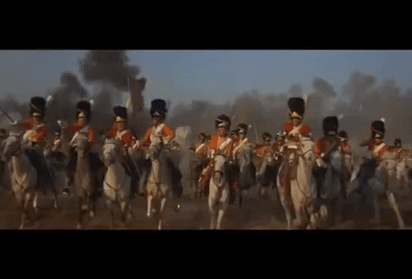
The charge saved the remnants of the Household and Union brigades but their casualties had been heavy, including the Greys’ lieutenant-colonel, James Hamilton, who was killed. The official recorded losses for both brigades that day were 1,205 troopers and 1,303 horses, an extremely high proportion.
However, 14,000 French troops of D’Erlon’s corps had been committed to the attack on the Allied centre at a cost of some 3,000 casualties and irrecoverable time. It was four o’clock before they were ready to advance again, by when, with the Allied line holding along the ridge and Prussian troops beginning to arrive on the field from the east, it was be-coming clear that Napoleon had lost the battle, although there would be another two hours of increasingly desperate, bloody but futile French attacks before Wellington judged it the moment to signal the whole line to advance.
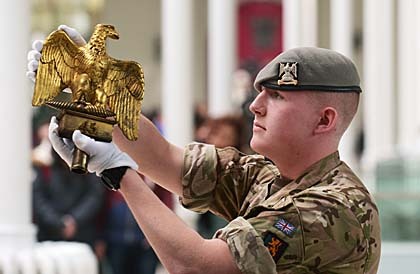
The Scots Greys would later incorporate the image of the captured eagle in their cap badge, and Sergeant Ewart would be commissioned as an ensign (second lieutenant) in the 5th Veteran Battalion of Infantry. The following year he was invited to a Waterloo dinner in Edinburgh, where Sir Walter Scott asked him to speak. But Ensign Ewart begged that he might be excused, saying, “I would rather fight the Battle of Waterloo over again than face so large an assemblage.”
The Battle of Waterloo, the culmination of more than twenty years of fighting in Europe and across the globe, was one of the greatest military defeats in history. Within a matter of hours it would not only result in thousands of deaths, but also in the destruction ofa well-experienced army.
The role that the Scots Greys played in the Battle of Waterloo was, perhaps something of a surprise. Although they had had a long and relatively distinguished history, having fought in many battles from the time of William III in Holland, the group tasked with fighting at Waterloo, the majority having little or no battle experience, proved themselves to be more than adequate on their day. Through sheer courage and determination they entered a bloody battle against all the odds.
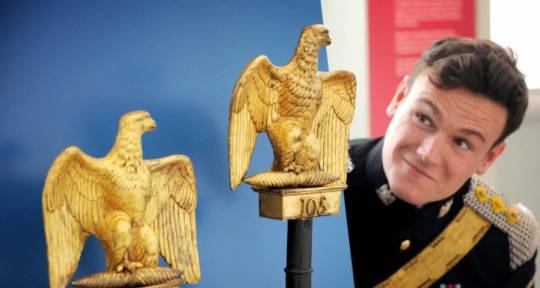
Historians continue to debate whether the Scots Greys was the actual turning point of the Battle of Waterloo with as much vigour as they debate the late intervention of Blucher’s Prussians. Be that as it may it remains undeniable that the number of losses, in proportion to their numbers, was very high, yet the impression they made on the battlefield at Waterloo was, and still is, deep and forever remembered.
#scots greys#waterloo#napoleon#eagle#history#british army#war#military history#napoleonic warfare#britain#france#prussia#regiment#duke of wellington
42 notes
·
View notes
Note
Another period piece drama ref for you -- a show called Belgravia. It's also by Julian Fellowes. I don't remember much what it was about other than it takes place around the Duchess of Richmond's infamous ball just before Waterloo.
It came out last year. ITV in the UK and Epix here in the US. I found it during one of the free cable weekends but you might be able to find it on Netflix or Prime or Hulu if you have those options.
I did watch Belgravia and really enjoyed it. I hope there will be another season of it.
12 notes
·
View notes